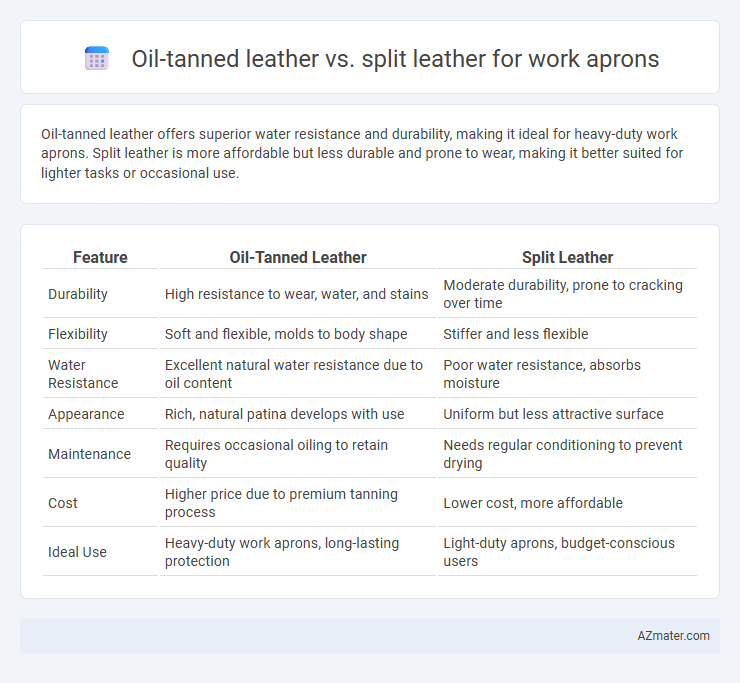Oil-tanned leather offers superior water resistance and durability, making it ideal for heavy-duty work aprons. Split leather is more affordable but less durable and prone to wear, making it better suited for lighter tasks or occasional use.
Table of Comparison
| Feature | Oil-Tanned Leather | Split Leather |
|---|---|---|
| Durability | High resistance to wear, water, and stains | Moderate durability, prone to cracking over time |
| Flexibility | Soft and flexible, molds to body shape | Stiffer and less flexible |
| Water Resistance | Excellent natural water resistance due to oil content | Poor water resistance, absorbs moisture |
| Appearance | Rich, natural patina develops with use | Uniform but less attractive surface |
| Maintenance | Requires occasional oiling to retain quality | Needs regular conditioning to prevent drying |
| Cost | Higher price due to premium tanning process | Lower cost, more affordable |
| Ideal Use | Heavy-duty work aprons, long-lasting protection | Light-duty aprons, budget-conscious users |
Introduction: Choosing the Right Leather for Work Aprons
Oil-tanned leather offers superior durability and water resistance, making it ideal for work aprons exposed to harsh conditions and heavy use. Split leather, derived from the lower layers of the hide, is more affordable but less resistant to wear and moisture, often requiring additional treatment for longevity. Selecting oil-tanned leather ensures a tough, long-lasting apron, while split leather suits lighter tasks and budget-conscious users.
What is Oil-Tanned Leather?
Oil-tanned leather is produced by soaking hides in a blend of natural oils and waxes, resulting in a durable and water-resistant material ideal for work aprons. This tanning process enhances the leather's flexibility and longevity, making it resistant to cracking and wear in demanding environments. Compared to split leather, oil-tanned leather offers superior strength and a more robust protective barrier against moisture and stains.
What is Split Leather?
Split leather is derived from the lower layers of a hide after the top grain has been separated, offering a more affordable and durable material option. It lacks the natural grain texture of oil-tanned leather but can be treated to improve water resistance and strength, making it suitable for heavy-duty work aprons. Compared to oil-tanned leather, split leather is less flexible but provides a rugged surface that withstands abrasion and heavy wear in industrial environments.
Durability Comparison: Oil-Tanned vs Split Leather
Oil-tanned leather offers superior durability for work aprons due to its dense fiber structure and enhanced resistance to moisture, abrasion, and wear. Split leather, derived from the lower layers of hide, is generally less durable and more prone to tearing and stretching under heavy use. For long-lasting protection in demanding work environments, oil-tanned leather is the preferred choice over split leather.
Comfort and Flexibility for Daily Use
Oil-tanned leather offers superior comfort and flexibility for daily use in work aprons due to its supple texture and natural resistance to moisture, which adapts to the wearer's body over time without stiffening. Split leather, while more affordable, tends to be less flexible and can become rigid after prolonged exposure to sweat and wear, reducing overall comfort during extended work periods. The durability and pliability of oil-tanned leather make it the preferred choice for professionals seeking a work apron that balances toughness with ease of movement.
Resistance to Water, Stains, and Chemicals
Oil-tanned leather offers superior resistance to water, stains, and chemicals due to its dense, oily finish that repels moisture and prevents absorption, making it ideal for heavy-duty work aprons. Split leather, derived from the lower layers of the hide, lacks the robust protective oils and is more porous, making it vulnerable to water damage, staining, and chemical exposure. For work aprons requiring durability and protection in harsh environments, oil-tanned leather outperforms split leather in maintaining integrity and longevity against liquid and contaminant exposure.
Maintenance and Longevity
Oil-tanned leather offers superior durability and water resistance, making it easier to maintain with periodic oiling to prevent drying and cracking, thus extending the lifespan of work aprons. Split leather requires more frequent conditioning as it is less dense and more prone to moisture absorption and wear, leading to a shorter lifespan under heavy use. Investing in oil-tanned leather aprons ensures long-term performance and reduced maintenance efforts in demanding work environments.
Price Differences and Value
Oil-tanned leather offers superior durability and water resistance, making it ideal for heavy-duty work aprons, though it generally comes at a higher price point compared to split leather. Split leather, derived from the lower layers of the hide, is more affordable but less durable and prone to wear over time, reducing its long-term value for intensive use. Investing in oil-tanned leather provides enhanced longevity and protection, delivering better value despite the initial cost difference.
Best Uses: Matching Leather Type to Workshop Tasks
Oil-tanned leather offers superior water resistance and durability, making it ideal for heavy-duty workshop tasks such as welding, metalworking, and carpentry where exposure to moisture and abrasion is frequent. Split leather provides a more affordable option with good flexibility and breathability, suited for lighter tasks like precision assembly, woodworking, and general maintenance. Matching oil-tanned leather with demanding, high-impact jobs and reserving split leather for less intensive tasks ensures optimal protection and comfort in work aprons.
Conclusion: Which Leather is Best for Work Aprons?
Oil-tanned leather offers superior durability, water resistance, and aging characteristics, making it ideal for heavy-duty work aprons that require long-lasting protection and comfort. Split leather, while more affordable and flexible, lacks the robustness and natural resistance needed for demanding work environments. For professionals seeking a high-performance work apron, oil-tanned leather is the optimal choice due to its enhanced toughness and weather resilience.

Infographic: Oil-tanned leather vs Split leather for Work apron
 azmater.com
azmater.com